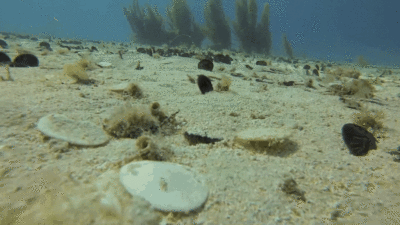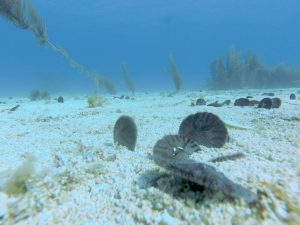
When someone mentions sand dollars, often what comes to mind are the stark white tests (a test is skeleton of an urchin) that wash up on shore. In fact, these tests are the endoskeleton of an animal that is normally covered in short, moveable dark purple spines. The Western Sand Dollar (Dendraster excentricus) is found along the entire west coast of the United States. On Catalina Island, the Western Sand Dollar is found on the sandy bottom of many coves. Most commonly they are seen in protected coves, where they tend to colonize shallower waters. Sand Dollars are members of the phylum Echinodermata, and their relatives include sea cucumbers, sea stars and sea urchins among others. Characteristics of this phylum include spiny skin, tube feet for locomotion, and radial symmetry.
 The flower-like pattern seen on the test of sand dollars is used for gas exchange. Sand dollars feed by burying themselves “standing up” in the sand. They are able to do this because they are slightly heavier on one side. If you look at their test, you will notice the flower pattern is positioned off-center. This imbalance is called eccentricity and allows them to utilize the current for suspension feeding. Sand dollars are also thought to consume sand to weigh them down and remain on the sea floor. Sand dollars position themselves parallel to the surge current, allowing water to flow past their specialized feeding spines. It is thought that sand dollars often position themselves near each other to feed to increase the current flowing between them. When small organic particles flow past the upright sand dollars, they are trapped in the mucous excreted by the feeding spines and brought to the mouth on the flat “bottom” of the sand dollar, called the oral surface. The aboral surface, or side opposite the mouth, bears the flower pattern.
The flower-like pattern seen on the test of sand dollars is used for gas exchange. Sand dollars feed by burying themselves “standing up” in the sand. They are able to do this because they are slightly heavier on one side. If you look at their test, you will notice the flower pattern is positioned off-center. This imbalance is called eccentricity and allows them to utilize the current for suspension feeding. Sand dollars are also thought to consume sand to weigh them down and remain on the sea floor. Sand dollars position themselves parallel to the surge current, allowing water to flow past their specialized feeding spines. It is thought that sand dollars often position themselves near each other to feed to increase the current flowing between them. When small organic particles flow past the upright sand dollars, they are trapped in the mucous excreted by the feeding spines and brought to the mouth on the flat “bottom” of the sand dollar, called the oral surface. The aboral surface, or side opposite the mouth, bears the flower pattern.
On Catalina Island, Sand dollars are susceptible to predation by fish such as the California Sheephead, crabs and sea stars are also common predators. Though living together in large beds provides some protection, predation remains heavy. Old age is often thought a major cause of death for the Western Sand Dollar, with a life span ranging from 1 to 15 years.


